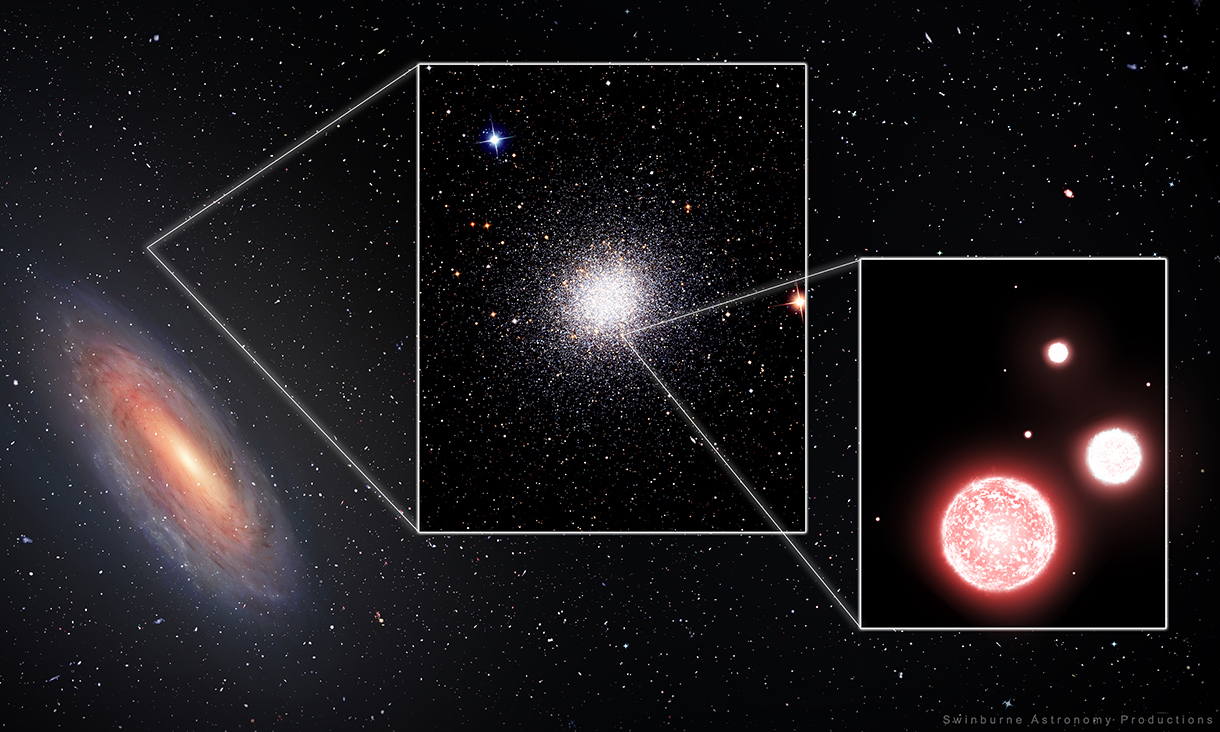Astronomers discover metal-poor globular cluster

Artistic representation of the Andromeda Galaxy with globular cluster RBC EXT8 and its metal-poor stars. Globular clusters contain some of the oldest stars in a galaxy.
In summary
- Astronomers have found a globular star cluster with a record-breaking low amount of metals
- Globular clusters are key components of galaxies thought to form very early in the history of the Universe
- The cluster of stars was found in the halo of the Andromeda galaxy
An international team of astronomers including Director of Swinburne’s Centre for Astrophysics and Supercomputing (CAS), Professor Jean Brodie, has discovered a globular cluster of stars that contains extremely few metals.
The interesting cluster of stars was found in the Andromeda galaxy. Galaxies, like Andromeda and the Milky Way, are massive systems made of billions of stars, gas, dust and dark matter.
So why is one group of stars so important?
“Stars tell us important things about galaxies and their history, helping us understand more about how they form and change over time,” says Dr Rebecca Allen, a galactic astronomer at CAS, not associated with the study.
This system of stars (about a million of them in a spherical bundle) is what astronomers call a globular cluster. It is located in the outskirts, or halo, of the Andromeda galaxy. Globular clusters are key components of galaxies thought to form very early in the history of the Universe. They are bright fossils that trace the mergers and acquisitions that build up the galaxies we see today.
Until now large globular clusters all contained at least a certain amount of metals, which set limits on where and when they could have formed. As galaxies evolve and grow over time, stars are formed and die, increasing the quantity of heavy elements present in the galaxy. The more massive a galaxy is the more metals it should have.
This is where the globular cluster, called RBC EXT8, comes in. It is extremely metal poor, but also massive. The stars in the cluster have, on average, 800 times less iron than our Sun and are three times more iron-poor than the previous globular cluster record-holder. EXT8 is also extremely deficient in magnesium.

Director of the Centre for Astrophysics and Supercomputing, Professor Jean Brodie.
“As a high-mass cluster, it should have been made by a relatively high-mass galaxy, which in turn would have a relatively high metallicity,” says co-author of the study, Professor Brodie.
“The issue is that very low metallicity clusters are expected to form in very low-mass galaxies, which can make only low-mass clusters. Such clusters would then have dissolved by the present day.
“This discovery is exciting because the idea of a ‘metallicity floor’ for globular clusters, that must contain some minimum amount of heavy metals, underpinned so much of our thinking about how these very old star clusters formed in the early Universe.
“Our finding contradicts the standard picture and that is always fun!”
The findings are published in the journal Science.
-
Media Enquiries
Related articles
-

- Astronomy
- Technology
- Health
- Science
- University
- Sustainability
- Engineering
Swinburne highly cited researchers reach the top in 12 fields
Ten Swinburne academics have been named on the Highly Cited Researchers 2025 list, released by Clarivate
Tuesday 02 December 2025 -

- Astronomy
- Technology
- Science
- Engineering
Meet Swinburne’s Roo-ver Mission team
Roo-ver will be Australia's first lunar rover, and it’s being designed, built and tested in Australia. Swinburne is playing a key role in the design and construction of Roo-ver, through its involvement in the ELO2 Consortium.
Wednesday 26 November 2025 -

- Astronomy
- Technology
- Science
- Aviation
- Engineering
Shaping space innovation at the International Astronautical Congress
The 76th International Astronautical Congress (IAC) united over 7,000 delegates from more than 90 countries to explore the future of space. Swinburne staff and students delivered 20 talks, panels and presentations, showcasing Australia’s growing leadership in research and education.
Friday 10 October 2025 -

- Astronomy
Indigenous students explore the cosmos through Swinburne’s astrophysics program
Indigenous students explored astrophysics at Swinburne, connecting science and culture while building pathways to future careers in STEM.
Friday 19 September 2025 -

- Astronomy
- Science
Swinburne’s space stars on show at Parliament House
Swinburne University of Technology hosted a three-day exhibition at Queens Hall in Victoria’s Parliament House . The showcase highlighted the innovative work being done at Swinburne to support the burgeoning space science sector.
Friday 30 May 2025

